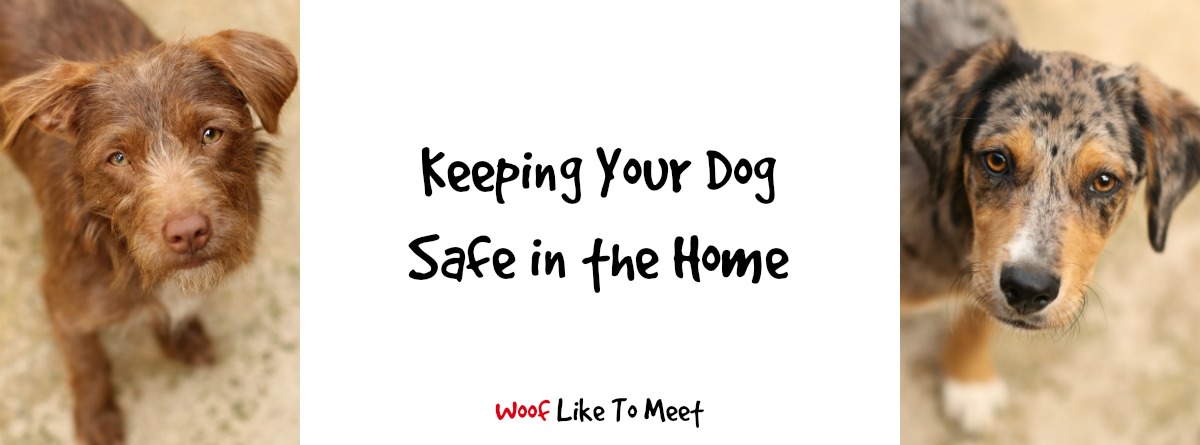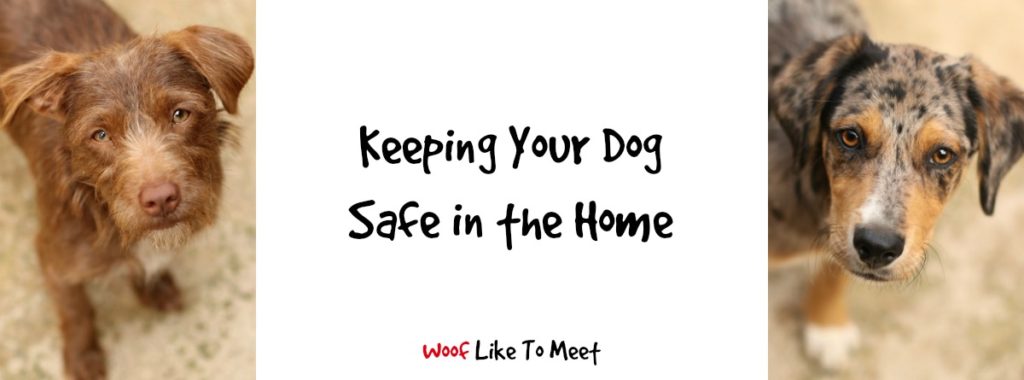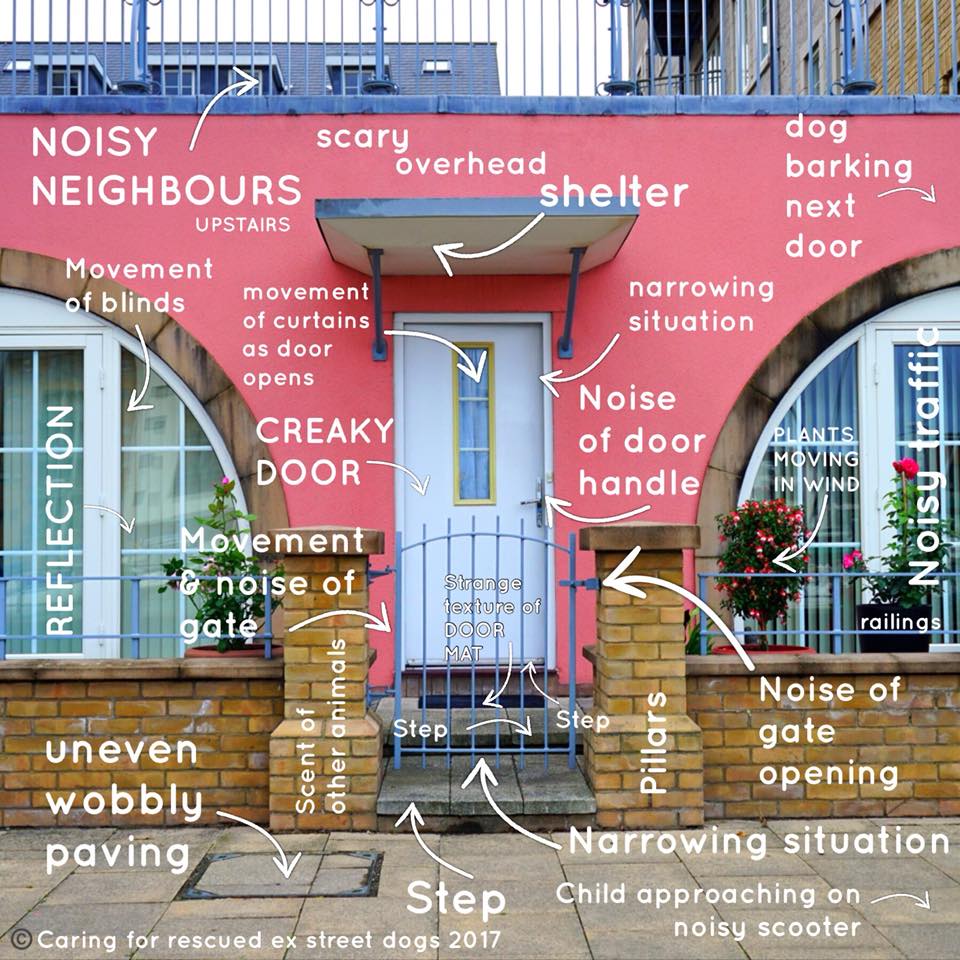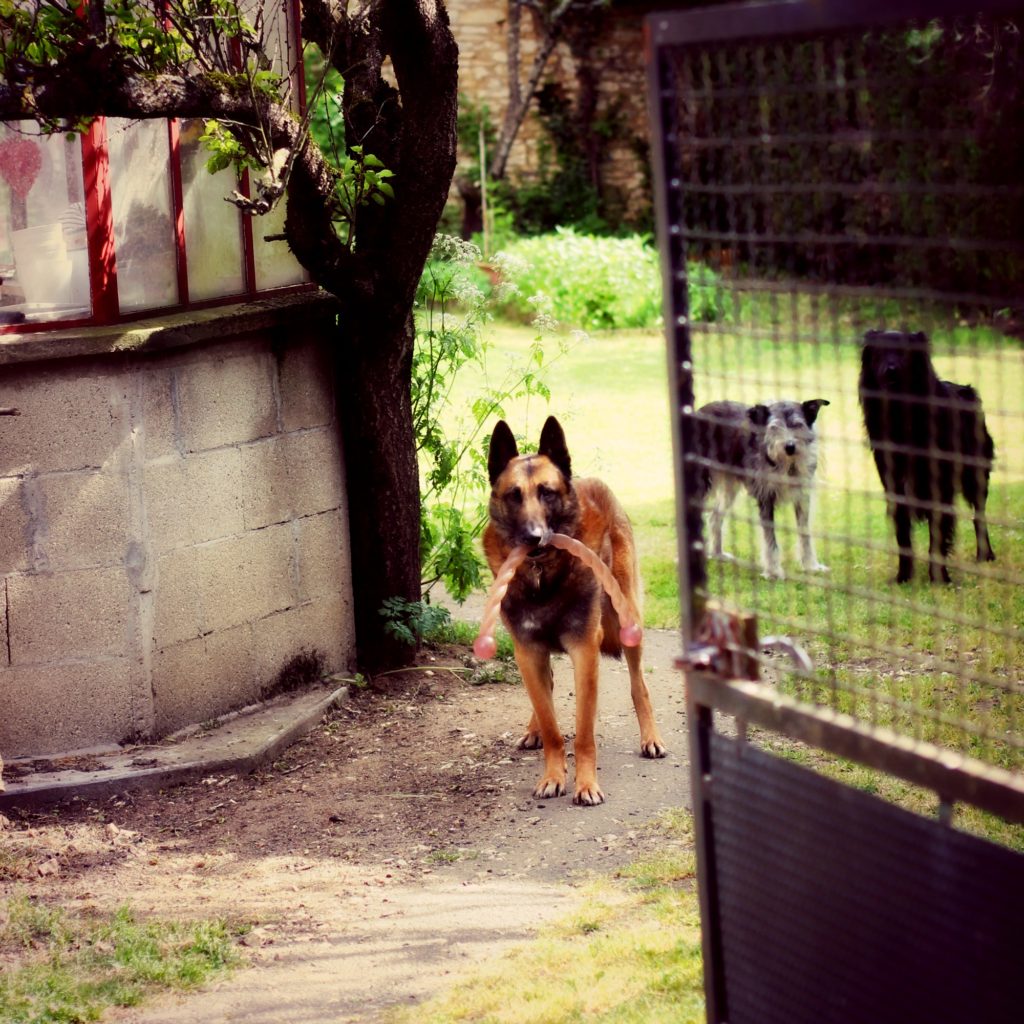Last week I did a post about keeping your dog safe on walks. That related to all kinds of issues from chasing small critters, chasing cars or joggers, fearfulness or spookiness in public, aggressive behaviour in public or even those dogs who just like rampaging up to picnickers, scoffing the lot and racing off with the tablecloths. If you have a dog whose recall is poor or unreliable, or whose behaviour puts them (or others) in danger, that’s your first place to start.
Whilst a home should be a safe place, so many incidents take place there that you’d be forgiven for thinking it was a major hazard zone. Whether you’ve got a puppy, a dog with anxiety, a dog who’s aggressive or unpredictable towards unfamiliar people, other dogs in your home or towards guests, giving your dog a safe place is absolutely vital.
And that will need to be a place we can secure, from time to time. We can’t just teach our dog ‘Go To Mat’ and hope they’ll stick at it, not unless we work at it like mental. I’ll never forget seeing trainer extraordinaire Susan Garrett and her five collies. The doorbell rang and all five of those collies ran to their beds and sat there like their butt was glued to the bed. Oh how I wish! Not so easy with dogs coming and going here all the time and so very many years of practice at ‘alternative’ behaviours like jumping, barking or even peeing on the floor when guests arrive.
Teaching ‘go to mat’ or teaching your dog to go to a space when things happen is great though. It’s definitely something I’d put on a puppy’s ‘thing to learn’ chart and it’d certainly stop a lot of door dashing.
But a puppy can’t be expected to be glued to a mat twenty hours a day. So they’ll need a safe space as well as this behaviour unless you plan on supervising them every waking moment.
Why do puppies need a safe space?
Because you can’t supervise them twenty-four hours a day. You need a place that can act as a physical babysitter, so that you can have a bath or go in the kitchen without worrying about whether your puppy is dismantling the sofa, surfing the counters, peeing on the furniture or eating the wires. A safe space is about navigating early learning so that newly discovered ‘fun stuff’ doesn’t become the beginnings of a very bad habit. Why do we take kids to soft play and ball pits and jungle gyms? Because they’re fun and they’re safe. We don’t take them to antique shops or Wedgwoods outlet shop to play around china do we? We do stuff all the time to stop our kids breaking things or touching things they shouldn’t. If you’re not doing the same for your puppy, then you really need to look at your values about this family member. Are you seriously expecting a puppy to just deal with all those wooden chair legs that look so very much in need of chewing? Or those shoes that are just weird pieces of leather that absolutely must be designed for chewing? Don’t expect your puppy to be any more sensible around your Villeroy and Boch fine dining tableware when your kids eat off plastic plates and you give them a drink in a beaker.
What about older dogs?
Ah, this is where I remember my old Ralf with fondness. Ralf, a 13-year-old former guard dog who lived with me for a brief but love-filled seven months back in 2014. Ralf who could take tin cans apart with his teeth. Ralf who ate a kilo of sugar. Ralf who destroyed all my packs of pasta, decided he didn’t like them and left their contents over the kitchen floor. Ralf who was the reason I had to put all my dog food under lock and key.
Yes it’s cute. Yes, it can be dangerous. I came home one day to find Amigo with his head stuck in a biscuit bag and Tilly guarding the kitchen from three dogs who were at least three times her size. I was lucky. I shouldn’t depend on luck to keep my dogs safe.
So the food went away. The kitchen found a door. Ralf’s foraging days were over.
He wasn’t the only one of my dogs who could open doors. Effel the beauceron did a good job ‘trying’ to open the door. One wrecked door later and the dog food found a new home.
So just for your common-or-garden dogs who have no particular bad habits, a secure space in the home is an essential. Ralf, Amigo and Effel were great dogs, but to expect them to resist temptation when I’m absent is a big ask.
After all, even by the age of five not all children will wait for a bigger reward later – and that’s for human children with their developing ability to understand consequences!
So expecting a dog to leave the marshmallow when there are no better consequences if they leave it til later… quite frankly that’s just ludicrous. In Ralf’s case, have sugar now and have food later too. Those two things were not linked in his head. Neither were ‘have sugar now and have tummy ache later’.
Also, you wouldn’t punish a four year old for not being able to delay reward, so punishing a dog who understands even less is just so irrational of us as humans that you’d have to ask if we actually have any sense of theory of mind or understanding of other species’ capabilities at all. Would you really go into that room and tell that little girl off for eating a marshmallow? Or wetting her bed?
Yet we expect more of our dogs than we do of five-year-olds in many cases!
It’s not just about learning to delay rewards.
Dogs also learn by trial and error: jump at the door handle often enough and one day, you’ll press the lever and be free! Flika is a devil for opening doors. There is some evidence that dogs learn by watching and mimicking (although not like apes do) and Heston learned that delightful trick from her – something I have to keep my eye on.
And that’s just your normal dogs doing normal everyday kind of stuff… opening front doors and gates, foraging in cupboards and chewing shoes.
A safe space is vital.
For fearful dogs, having a secure space is absolutely essential. It may only take the door being open that split second and a loud bang for the dog to choose flight over all other reactions. I know I don’t need to explain how many fearful dogs run off during thunderstorms. Living with the noise-conscious Flika has given me more of an insight… low flying planes, noisy motorbikes, tractors, lorries going too fast, cyclists, people chatting… they’re all enough to spook her even when she’s in the house. Luckily, she chooses fight over flight, barks at the thing and – surprise, surprise! – the thing goes away. Very effective for Flika. But for fearful dogs, the risk of flight is huge. For dogs with severe separation anxiety or hyper-attachment, it’s not uncommon to find them trying to escape to get to you. I’ve had two that can do this.
This image from Caring for rescued ex-street dogs shows just how many things can set off a fearful dog outside the home.
Do you think it’s much different INSIDE the home, especially for a dog who has never been in a house?
For dogs who’ve lived outside, claustrophobia can be a real issue. Imagine being trapped in a prison you can’t escape from with noisy machines and hoovers and pings, beeps, alarms. Let’s not forget the television and the people. Can you imagine if you were fearful of dogs and being trapped in a house with four big dogs?
Now imagine being a dog who is scared of people and being trapped in a house with four big, hairy scary humans.
Horrifying thought.
For aggressive dogs, a safe secure space is also vital. Aggression is part of the normal canine behaviour repertoire. That dogs are territorial shouldn’t come as a ‘Breaking News!’ kind of story. That some dogs don’t like new stuff, don’t like unfamiliar people or don’t like unfamiliar dogs is not newsworthy either. But you don’t want a dog barrelling out of your front door to bite the postal worker or your Auntie Dot’s bichon, make sure your dog is secure.
It’s also true of dogs with predatory behaviours – even if the worst they’d do would be chase. Do you think an open window is much of a hindrance to a greyhound who’s just seen a cat jump over the fence?
Needing a secure space is also necessary for dogs who are curious with low fear levels. Call it foolhardiness or just plain stupidity, but I once watched a dog about to jump out of a third-floor window because her owners were outside. Dogs naturally should be fairly fearful of big drops, but not Maya. If you have a dog who is curious and a risk-taker, security will be paramount.
So very, very many reasons why homes might not be as secure as we think and why our dogs need to have a secure place. We just can’t expect the ‘perfect’ dog who doesn’t chew in our absence, who doesn’t pee on things, who doesn’t stay put. We’re not Susan Garrett with her fabby collies. And our dogs might be able to manage a 10-minute ‘go to mat’ exercise, but we shouldn’t expect them to be able to hold that for five hours when we have guests.
We don’t think, either, that we might need our dogs to be secure when they’re older in ways they never were as a young dog. Maybe we have the perfectly behaved dog (oh my Heston, you are such a good boy!) who doesn’t escape, who doesn’t chew, who isn’t fearful, who isn’t predatory and who can cope with open gates as long as nothing too untoward happens on the other side. Yet dogs with canine cognitive dysfunction (doggie dementia) can suddenly need a safe place in ways they didn’t when they were young. Amigo would pace and pace in the night – and it wasn’t safe with other dogs about since he was deaf – he couldn’t hear their growls and couldn’t see them. I wished then that my other dogs were crate-trained so that I didn’t worry about a fight. You can’t crate train a dog with dementia… it’s hard enough to be losing your understanding, but to be put in a crate as well?
And that brings me on to another reason to keep your dogs secure. Some of the worst dog/dog injuries I’ve seen (and even dogs who’ve killed another dog) have been during owner absence. Redirected aggression over an exciting moment like an owner’s car pulling up or someone knocking on the door or a cat passing the window have been the triggers for some pretty hideous fights. I don’t ever – never, never, never – leave a new dog alone with all my others. I don’t leave dogs of disproportionate sizes alone in my absence. I don’t leave anxious pacing dogs alone with my others. When I first leave a dog with my others, I do so for five minutes and I video. And then for ten or fifteen minutes, again with video. That way I can see for sure what’s happening.
So as you can see, there are so very many reasons why you need a safe, secure place.
That boils down to ‘Dogs are dogs’.
No wonder so many dogs end up being banished to a yard. Being in the house unsupervised is really, really hard!
So what can you do to secure a space for your dog?
This is where baby and toddler stuff can be really useful.
Baby gates are great if you have stairs. And if your dog can jump them, put another one above the first. Make sure there is no gap and if you have a very determined escape artist or a gap, a roller at the top is a bonus.
You can make ones with steel or aluminium tubing as well if you’ve got Man Tools.
Of course, doors are a bonus. But doors can be easily destroyed… unless you fit metal plates to them or buy a security door. No they don’t look pretty. Who wants to live in a home that looks like a workshop? But your dog is safe. And you only need one room to do it.
Some people may change handles to knobs. Just a word of caution. It is VERY easy for a dog to jump and get their collar caught on a doorknob. I know seven dogs who died last year as a result of this sadly very common situation. If you have an escape artist, you’re going to want a collar with a tag on it, but those can so easily snag on a knob. I’d either remove the collar and have them chipped or wearing a harness with a tag on it, or stick to flat handles. Our shelter used to have a gate with a flat handle which pointed to 6 o’clock so that our resident guard dog Belle couldn’t open it. One at 3 o’clock or 9 o’clock is easy to jump on. One at 6 o’clock pointing downwards can still be operated by humans, but not so easily by a dog. Belle never managed it.
Hook and eye locks or sliding bolts are useful too, although I know dogs who can flick hook and eye locks or pull sliding locks with teeth. Fitting one to the upper part of the door where it’s out of reach of a dog’s height when standing on back legs is straightforward enough.
But for most dogs, a simple closing door with a handle and a simple lock if necessary is more than enough. Add a baby gate for stairs or wherever and you’re probably more than secure.
I’m talking about the super-dog escape artists.
Want more?
Metal panels attached either side of a door can stop them tearing through partition walls. A handleless metal-plated door with security locks is not a door that can be opened by a dog, teeth or claws, jumping or trial and error.
I work on a ‘two-door’ system as well. I want there to be two doors between a dog and whatever its target is. Got a super territorial dog with a bite history that you love dearly and want to keep from a mandatory euthanasia order? I want two dog proof, lockable doors between it and the postal worker. The dog is safe, the postie is safe.
Crates are great for small dogs, but be sure to get a sturdy one. I’ve had a 5kg minpin with severe separation anxiety wreck a crate in minutes. Make sure you train it and desensitise a dog to it: don’t expect them to like being in a crate especially if they can see or hear you.
X-pens are also useful. Baby parks and playpens are fine for little dogs who can’t clear it, and rollers around the top will stop them getting leverage on the edge. These are not very secure, so you need to bear it in mind that they can easily be knocked over.
If you have a dog who is such a risk that you’re thinking of rollers and double-locked double-door systems with ‘air-lock’ type entries, then it’s vital you get help too. If this need is caused by fear, then medication should be an option here.
If your dog is so aggressive or presents such a risk to guests that they need such a system, then you need to be working with great behaviourist or trainer who knows how to work with these in fear-free ways. Intimidation, threat and coercion will only suppress emotions. I don’t have to tell you about the owner who used these methods to stop his predatory huskies chasing his cat. He usually kept the animals separate, but one day the huskies got out and he came home to a dead cat. A secure area and caution would have managed the situation much better. But because he thought that his “no!” training had worked, he stopped taking precautions. All that had happened was the dogs learned not to chase the cat when the owner was present. The owner relaxed and got a bit careless. And the huskies cottoned on to the fact that when no-one was present, they could do what they liked.
Just a note of caution about ‘containment systems’ using shock or static, vibrations or otherwise. These tend to give a level of confidence that is unwarranted and unmerited. I’ve seen broken wires, mains failures, dogs who barrelled through them anyway. When the stakes are high, these are not secure and a dog will risk it for a biscuit. Plus, they work by building in fear of punishment, pain or discomfort. If you have a fearful dog, do you really want to make them MORE afraid? If you think that a predatory dog will put aside automatic behaviours or even be put off by a shock, you need to hope that never fails. And a hope is all it is. Batteries die. Mains power has cuts. Plus, the desire to chase or kill can be so powerful that punishment would need to be ramped up really high to work. And if you have an aggressive dog whose target is on the other side, what effect do you think adding a punisher will have? Either suppress the behaviour and never overcome it, or even increase the fear or anger that leads to the aggression in the first place. There are so many, many reasons not to rely on ‘electronic’ containment systems, and the devices fail more than you know. Fitting them is an art in itself. Too loose and you could end up thinking it wasn’t working, so amp up the shock. Too tight and you can do some nasty burn damage. The stakes are too high to have confidence in this equipment.
Ultimately, a dog who is contained within four walls with a secure area filled with great, chewable, dissectable dog stuff and no access to things that could hurt them is a dog who is safe. There are many things that kennels are not great for, but keeping dogs safe is one of their virtues. When keeping a dog safe from the world (or even the world safe from it!) is of paramount importance, don’t take risks. I know we have an emotional response to a dog in a secure kennel run, to metal doors and rollers and airlocks. It makes us think of prisons and that makes us sad. We don’t want to think of our dogs being deprived of freedom or living in such ‘unwelcoming’ an environment. But our pretty wallpapered walls and parquet floors are aesthetically pleasing only to us. They pretty up OUR lockable secure prisons. A dog doesn’t care if you have metal panels on walls or if you have Sanderson’s Harlequin ‘Quintessence’ in lagoon blue and cerise from their ‘Standing Ovation’ line. It’s just a wall. Unless you have no doors, no fences and no gates, and your dog roams everywhere doing whatever they like, upstairs and downstairs running through the town like Wee Willie Winkie, then you already secure your dogs somehow. It may make you wrinkle your nose with distaste at the thought of a secure dog space that has had carpet or vinyl removed to stop them chewing it, but you won’t be getting home to find your dog has munched its way through your best Axminster carpet and is now in need of a very expensive surgical intervention to clear a stomach blockage.
If you have the kind of problem that baby gates, rollers, pens, crates and doors can’t solve, then you really need to find a good trainer or behaviourist to help you out. Sometimes it may be that you need to keep them very safe just for a short while as they learn to overcome the issues that require heavy-duty lockdown.
And if you have the kind of problem that baby gates, rollers, pens, crates and doors CAN solve, then you’re likely to find that your dog can quite easily be taught boundaries in positive ways that they actually respect when you are not there too. You’ll find a trainer can help with those things!
Here are three of mine who were learning not to gate-dash. I was behind the camera waving leads and chicken at them. When you find being inside much more rewarding than life outside, then you’ve cracked it!
None of my current dogs have any problem being given the run of the house. They no longer need supervision. There have been times when I’ve needed to secure a zone for one reason or another, but doors are more than enough. Heston had the beginnings of a chewing habit, so a door and tidying up nipped that in the bud. Tilly had problems with housetraining for a few months when she arrived, and being restricted from less familiar rooms put an end to that.
Flika is a little different. She WILL destroy doors in a bid to escape during storms or when I’m absent. We’re managing that through medication, supplements and through desensitisation, as well as through babysitters and her coming with me. But she’s 14. My hopes of a positive prognosis for her ever learning how to be on her own in the house for an extended period are low. Were she younger, I’d be making more of an effort to help her cope rather than adapting my life to suit her. This reminds me to finish with an important statement…
Keeping your animals safe is crucial. Preventing them from practising behaviours when unsupervised is vital. But nothing will change your dog’s underlying reasons for needing this security unless you invest in a programme to overcome it.
That means understanding the reasons behind it and getting to grips with the underlying emotional causes of their desire to break free. Whether it’s anxiety, full-blown phobias, boredom, not knowing how to be on their own and settle, territorial behaviours, predation, chase behaviours or even that they see the best defence as a good offence, you need to understand what’s driving those needs and deal with that. Then you may find that you don’t need to turn your home into Alcatraz.
Next up: keeping your dog safe in the garden




